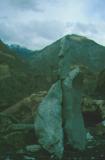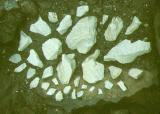The pictures presented here are part of a series entitled `Man and
rock in the Shimshal Valley'. The Shimshal valley is a remote cleft in
the Karakoram range, lying in Northern Pakistan, in the area disputed
with India. I spent three days walking in the valley, and was struck
by the desolation of a landscape made entirely of rock, yet bearing
the signs of centuries of human occupation. In the strange and wonderful landscape I was inspired to leave more fantastic lapidiary traces.
|
The valley
stretches East from the Karakoram highway, winding between high stone
butresses which obscure the lofty snow-capped mountains of the
Karakoram range, Lupghur Sar, Yazghil Sar. and many more. One enters
the valley through a fissure in the side of the Hunza valley, almost
imperceptible until one is standing at the entrance to the hidden
valley. |
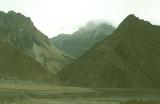 |
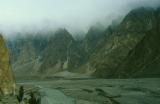 |
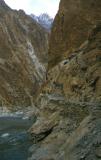 |
Entering the valley is like being swallowed by some huge monster. The
mountains tower overhead, blocking out the light. Within a few yards,
one has rounded the corner and the outside world ceases to exist. One
can see only a few hundred yards in front or behind, but looking up
the peaks crowd the vertiginous skyline. From that point the jeep
track snakes on, sharing the valley floor with the jealous Shimshal
river that every year washes it away. When
sight of the Hunza valley is lost, one becomes aware that there is no
other living thing in sight. All around there is nothing but the
raging glacial waters of the river, huge expanses of raw and shattered
rock and, high above, a small patch of sky. |
| The jeep track though is a sign of man's influence in the
valley. For many years, teams of villagers have struggled to build
this track ever closer to the village. Soon, I came to a cluster of
tents around the ballast track. Among them were two men huddled over
something. As I approached I saw that it was a goat. They struggled to
kill the exhausted animal with a blunt knife, trying to prepare lunch
for the other workers who were labouring on the track further along
the valley. |
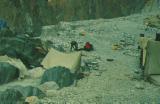 |
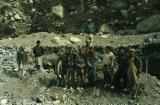 |
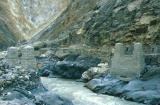 |
Trekking on up the valley, I passed
the end of the jeep track, crossing the river by perilous aerial
runways, alone among the powerful elements. |
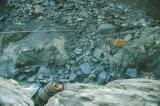 |
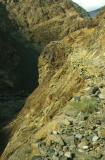 |
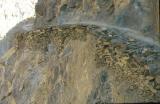 |
But for the narrow strip of path, this is wilderness, where only
elemental forces seem to act- the tumbling irresistable waters of the
river, the tectonic thrusts of the mountains, the relentless erosion
of winter cold, and the entropy imparted throughout by
all-pervasive gravity. Yet, walking on, one becomes aware that in this
wasteland there are the signs that man has been here for
thousands of years, leaving traces all around the valley as signs of
his struggle to survive in; to communicate through; and to tame the
landscape. |
|
The path on which I walked had been honoured by the tread of
passers-by for countless years, a delicate ledge scratched in the
hillside, narrowing to six inches and in parts swept away by an
incautious footfall, leaving an unbroken slope careering into the
vertiginous depths. In places the path is carefully constructed from
towers of stones balanced on one another ten feet deep to make the
narrow ledge, snaking onwards into the valley. |
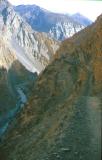 |
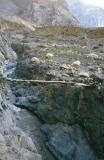 |
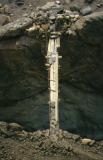 |
Elsewhere, stones have
been used in the construction of an impromptu suspension bridge,
making precarious-looking piers and patching holes in the walkway. |
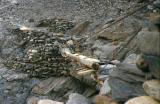 |
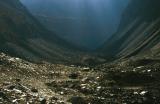 |
The rocks themselves
posess an eerie beauty, when undisturbed by man. Rocks in the side
valleys glisten in the sun, untouched since the glaciers
retreated, though from here they have not retreated far. A river rock
nestles like a weathered human skull in a pothole. The loose rock and
the bedrock in a reflexive bond, each eroding the other until their
curves match perfectly. |
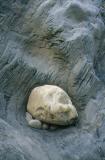 |
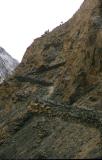 |
Here the path zig-zags perilously up to a pass, Wahini Pir: a plateau of shattered rock.
|
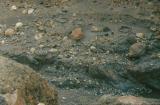 | Mysterious circles appear on
the valley floor. Symbols from an untold age of the sites of tents. At
Wahini Pir, the battle of humanity with the valley's rocks is shown by
a series of tiny huts built from stacked slabs of rock, and hinting at
parties of travellers trapped on the pass and scrambling to find
shelter from raging storms. But was this yesterday, or ten thousand
years ago? | 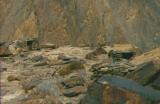 |
| Awed by the powers of nature here, and conscious of man's constant
struggle in turn fighting and exploiting the rock, I felt moved to
construct my own monuments to the supreme element of the valley. I
have constructed cairns elsewhere in the world, but none felt so at
home as in the Shimshal valley. The landscape is almost exclusively
rock, so materials are abundant. The way through the valley is
precarious and at times unclear, making the cairns serve their ancient
practical purpose of waymarking, and as a hommage to the people of the
valley who have worked their native stones for so many centuries a
cairns seemed a fitting, humble expression of my admiration. |
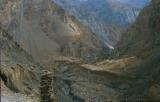 |
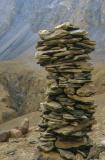 |
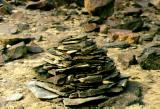 |
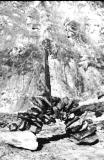 |
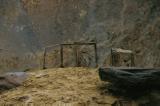 |
Tumulus, Pinnacle Arch and Slate Henge |
|
In the middle of the valley, at the confluence of two rivers, is
Habib's shop, isolated a day's walk from the nearest customer. |
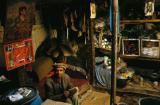 |
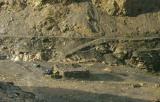 |
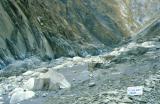 |
The `Village Guesthouse' (an abandoned road-builders' tent) where I stayed the night. |
|
Finally, out of the claustrophobic valley, to the Hunza valley and horizons that can be seen without peering upwards. |
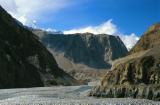 |









